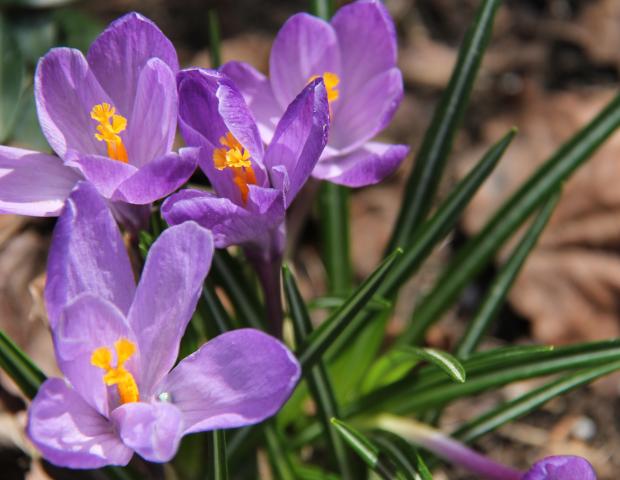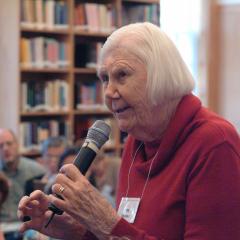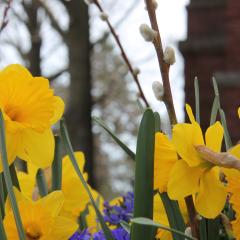What Is Peace?
To help commemorate our 30th anniversary year of 2023, we asked some scholar friends of ours to share personal reflections with us on the meaning of peace, learning, and dialogue. Here are five thought-provoking answers to the question: What is peace?
From David T. Hansen, John L & Sue Ann Weinberg Professor in Historical & Philosophical Foundations of Education, Teachers College, Columbia University
Peace is many things.
It is the sentiment of tranquility and calm that comes from beholding nature, or silently watching a parent with an infant, or a caregiver with an elderly person pushing them slowly around a garden in a wheelchair.
Peace is contemplation, pondering a question or issue with the inner eye.
Peace is meditation, emptying the mind and settling fully into the present moment.
Peace is a community in thoughtful harmony.
But peace can be elusive.
For the individual person, it can be hard to attain, to arrive at, to let happen. The sources of anxiety—peace’s adversary—are too multiple to list here. We know them all too well. They scatter peace to the winds.
Peace can be a maddening word, a taunting word, a tortuous word. It can be another word for tragedy. It is tragic that human beings resort again and again to violence—another of peace’s great adversaries.
We ask the child’s question “Why?” and have no answer.
Thus, peace requires faith. Not a naïve faith. Rather, a faith based on the abundant hard evidence that peacemakers can succeed, even if these countless successes do not in themselves eliminate violence from the human condition.
Imagine a world without peacemakers. That would be worse than tragic, so much worse there is no name for it (‘hell’ is too mild and off-target).
Humans are left with work to do. Peace is work, necessary work.
Peace summons what President Abraham Lincoln called the better angels of human nature. People can heed that summons, whether in the face of inner anxiety or outer violence. We can’t say why it’s good to do this, any more than we can say why these travails exist in the first place. But we know it’s good, and this knowledge is always there.
From Isabel Nuñez, Professor of Educational Studies and Dean of the School of Education, Purdue University Fort Wayne
For me, peace is an inner state of being. I am grateful that this is where I live most of the time. This gift of peace is grounded in a strong sense of self and self-regard that I hope doesn’t tip into arrogance. I don’t expect perfection from myself, and I don’t expect it from others. I enjoy every part of life and living; anything I don’t enjoy I avoid—or, if unavoidable, work to find what there is to like about it. I am pretty much always happy. This, to me, is peace.
Peace is a community in thoughtful harmony.
David T. Hansen
From Winston Langley, Professor Emeritus in the Department of Political Science and International Relations, and former Provost and Vice Chancellor for Academic Affairs, University of Massachusetts Boston
Peace is among the terms most frequently used by human beings and among the aims for which they most fervently yearn. Yet it has had no official or public definition, including in the fields of international and interhuman relations, where the term has been seen as most applicable. There are even crimes against peace—the planning, preparation, initiation, or waging of a war of aggression, or war in violation of international treaties. But there is no definition of what peace is—a rather uncomfortable reality, because one cannot have crimes against something, if that something is not defined. All that we have had is an unsatisfactory implication in the use or invocation of the term. The implication is that peace is the absence of war. And war has meant a condition of armed conflict within or between states.
The absence of a thing presumed to be to be its opposite (in this case war) does not tell us what the thing (peace) is, any more than the absence of greed suggests the presence of kindness and generosity. A thinker or two, including Buddhist philosopher and teacher, Daisaku Ikeda, have offered us a suggested definition, with the understanding that war is a condition of being imbedded in the coercive violation of human dignity, thus implicating the interdependent relationships that describe human beings and their activities, as individuals or as groups. Hence, Ikeda speaks of a culture of peace, as well as a culture of war. The latter is, therefore, not merely a matter of military coercion or armed conflict, but of the economic, social, psychological, moral, and spiritual strife that compromises what Ikeda describes as the “Greater Self” of individuals—a self that is embracing of all human beings, and that seeks a state of wholeness and a blending, not hostility, with all. Indeed, both war and peace begin with the individual.
Peace is a condition which comes to be as individuals, in full recognition of human dignity and the common humanity of every woman, man, and child, undergo a self-revolution that: overrides the ego; substitutes in her- or himself compassion for revenge, kindness for greed, and goodwill for hate; and opens that self to a dialogic relationship with every human being or group of human beings. Peace, therefore, is an on-going mode of being (not a fixed end) in which the Greater Self, in deep empathy with every other human self, finds ways to live in compassion, goodwill, kindness, and mutual dignity and development.
From Donna Hicks, Associate at the Weatherhead Center for International Affairs, Harvard University, and Author, Dignity: It’s Essential Role in Resolving Conflict
Peace is the internal state of being that comes with the recognition and acceptance of the value and vulnerability of all living things.
From Mary Lee Morrison, founding director of Pax Educare: The Connecticut Center for Peace Education, and author, Elise Boulding: A Life in the Cause of Peace
The essence of peace is promoting harmony, equality, and justice within and among individuals, communities, nations, and the world. It means a world where full human potential for everyone is reached and there is equal access for the basic resources of life, for accessing information, for education, and for the ability to actively question those in power. (Definition taken from our 2010 interview with Dr. Morrison.)
From Bill Schubert, Professor Emeritus of Curriculum & Instruction, University of Illinois at Chicago
I see learning, dialogue, and peace as building cumulatively on each other, any one of them needing the other two for a movement toward a continuously growing Wholeness, especially when perceived through the perspectives of Daisaku Ikeda and his mentors, Josei Toda and Tsunesaburo Makiguchi. It is my hope that educators should strive to inspire students by making explicit that they encourage these pursuits in all of their experiences, not only in school.
I see Peace as a state of being that grows from learning and dialogue as sketched [in my other two reflections*]. Through ethical and aesthetic transformation, peace-seeking joins imagination, wonder, insight, inquiry, and wisdom in action that returns human and other life forms to the Oneness whence they came. It overcomes the animate departure from unity with the inanimate, which forced life forms to survive through killing and consuming other life forms. I surmise that the resulting conquest, competitiveness, commodification, and acquisitiveness has led humans to bring ecological destruction upon all life forms. It accentuates the racism, classism, casteism, genderism, sexism, belief-ism, membership-ism, idea-ism, ageism, ableism, and more realms of prejudice that trigger still more separations. Perhaps, the fears associated with unleashed posthumanism, new materialism, and artificial intelligence are harbingers of the need to realize the necessity of the Buddhist and other belief systems that call for becoming One with All—perhaps a sentient, intra-cooperative, loving All—that is a place of Peace.
* See the What Is Learning? and What Is Dialogue? pages for Dr. Schubert’s reflections on those topics.



